Strategic Leadership: Personal Development Plan and Reflection
VerifiedAdded on 2023/06/03
|13
|3672
|126
Report
AI Summary
This report presents a comprehensive leadership development plan focused on personal growth as a strategic leader. It begins by outlining the essential characteristics of a good leader, including honesty, integrity, confidence, and strong communication skills. The report then delves into a personal analysis of leadership strengths, such as being highly organized, responsible, and visionary, alongside weaknesses like interpersonal skills and emotional control. A detailed plan is proposed to develop these leadership strengths, focusing on improving analytical skills, decision-making abilities, and soft skills through seminars, coaching, and practical application. The ultimate goal is to achieve a senior management position by addressing weaknesses and continuously polishing leadership talents, with a timeline of one year for significant improvement and preparation.

Paraphrase This Document
Need a fresh take? Get an instant paraphrase of this document with our AI Paraphraser
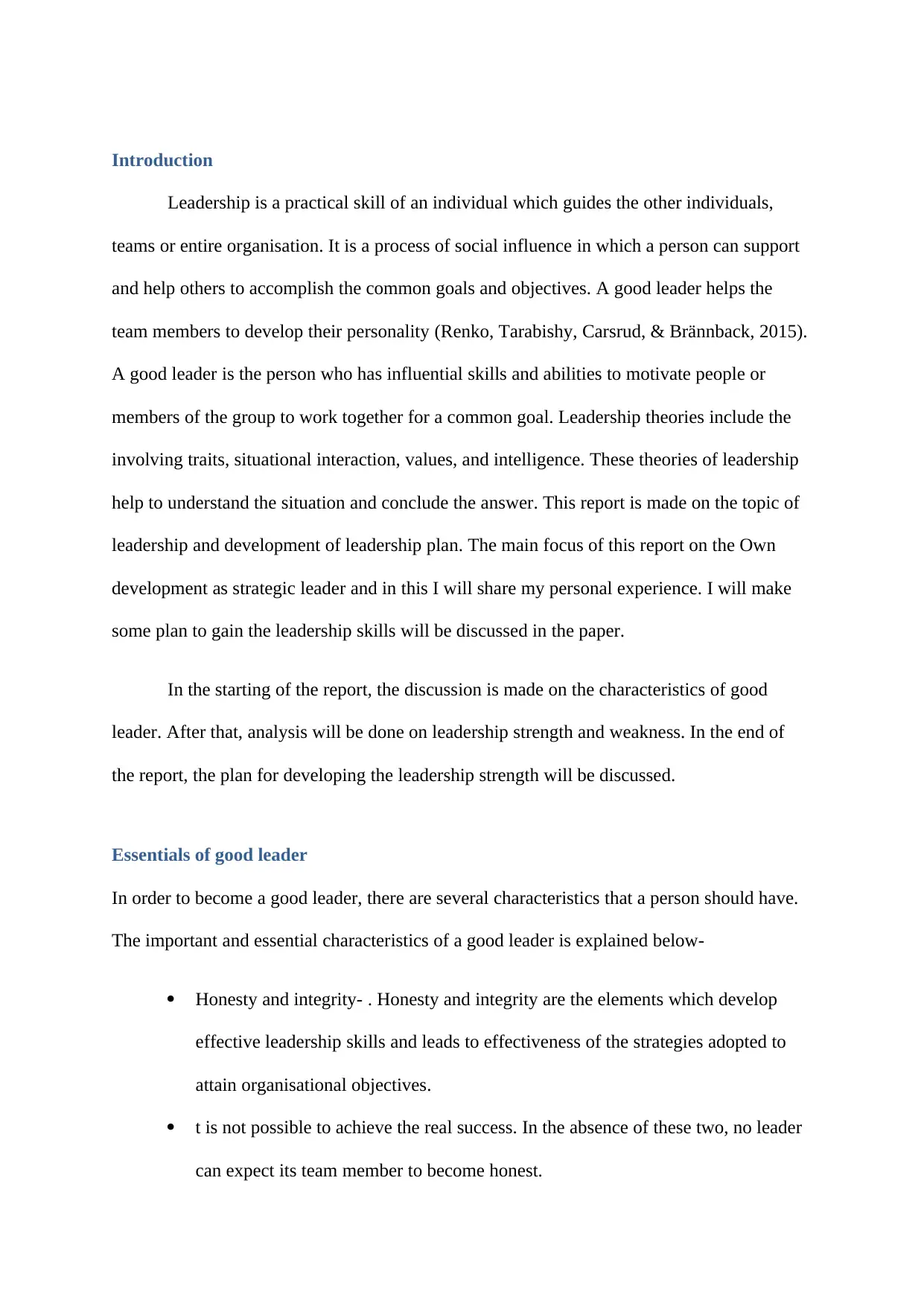
Introduction
Leadership is a practical skill of an individual which guides the other individuals,
teams or entire organisation. It is a process of social influence in which a person can support
and help others to accomplish the common goals and objectives. A good leader helps the
team members to develop their personality (Renko, Tarabishy, Carsrud, & Brännback, 2015).
A good leader is the person who has influential skills and abilities to motivate people or
members of the group to work together for a common goal. Leadership theories include the
involving traits, situational interaction, values, and intelligence. These theories of leadership
help to understand the situation and conclude the answer. This report is made on the topic of
leadership and development of leadership plan. The main focus of this report on the Own
development as strategic leader and in this I will share my personal experience. I will make
some plan to gain the leadership skills will be discussed in the paper.
In the starting of the report, the discussion is made on the characteristics of good
leader. After that, analysis will be done on leadership strength and weakness. In the end of
the report, the plan for developing the leadership strength will be discussed.
Essentials of good leader
In order to become a good leader, there are several characteristics that a person should have.
The important and essential characteristics of a good leader is explained below-
Honesty and integrity- . Honesty and integrity are the elements which develop
effective leadership skills and leads to effectiveness of the strategies adopted to
attain organisational objectives.
t is not possible to achieve the real success. In the absence of these two, no leader
can expect its team member to become honest.
Leadership is a practical skill of an individual which guides the other individuals,
teams or entire organisation. It is a process of social influence in which a person can support
and help others to accomplish the common goals and objectives. A good leader helps the
team members to develop their personality (Renko, Tarabishy, Carsrud, & Brännback, 2015).
A good leader is the person who has influential skills and abilities to motivate people or
members of the group to work together for a common goal. Leadership theories include the
involving traits, situational interaction, values, and intelligence. These theories of leadership
help to understand the situation and conclude the answer. This report is made on the topic of
leadership and development of leadership plan. The main focus of this report on the Own
development as strategic leader and in this I will share my personal experience. I will make
some plan to gain the leadership skills will be discussed in the paper.
In the starting of the report, the discussion is made on the characteristics of good
leader. After that, analysis will be done on leadership strength and weakness. In the end of
the report, the plan for developing the leadership strength will be discussed.
Essentials of good leader
In order to become a good leader, there are several characteristics that a person should have.
The important and essential characteristics of a good leader is explained below-
Honesty and integrity- . Honesty and integrity are the elements which develop
effective leadership skills and leads to effectiveness of the strategies adopted to
attain organisational objectives.
t is not possible to achieve the real success. In the absence of these two, no leader
can expect its team member to become honest.
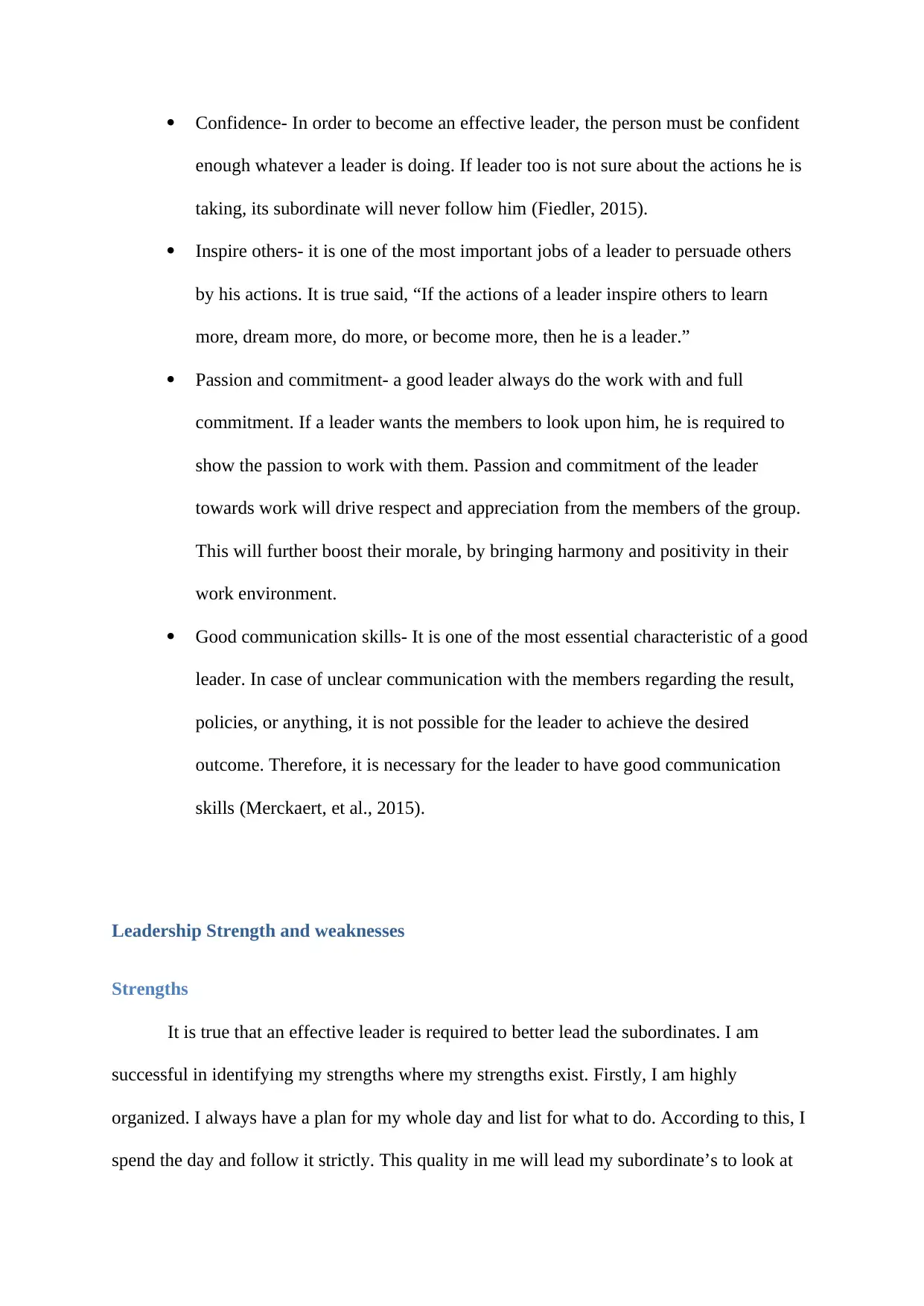
Confidence- In order to become an effective leader, the person must be confident
enough whatever a leader is doing. If leader too is not sure about the actions he is
taking, its subordinate will never follow him (Fiedler, 2015).
Inspire others- it is one of the most important jobs of a leader to persuade others
by his actions. It is true said, “If the actions of a leader inspire others to learn
more, dream more, do more, or become more, then he is a leader.”
Passion and commitment- a good leader always do the work with and full
commitment. If a leader wants the members to look upon him, he is required to
show the passion to work with them. Passion and commitment of the leader
towards work will drive respect and appreciation from the members of the group.
This will further boost their morale, by bringing harmony and positivity in their
work environment.
Good communication skills- It is one of the most essential characteristic of a good
leader. In case of unclear communication with the members regarding the result,
policies, or anything, it is not possible for the leader to achieve the desired
outcome. Therefore, it is necessary for the leader to have good communication
skills (Merckaert, et al., 2015).
Leadership Strength and weaknesses
Strengths
It is true that an effective leader is required to better lead the subordinates. I am
successful in identifying my strengths where my strengths exist. Firstly, I am highly
organized. I always have a plan for my whole day and list for what to do. According to this, I
spend the day and follow it strictly. This quality in me will lead my subordinate’s to look at
enough whatever a leader is doing. If leader too is not sure about the actions he is
taking, its subordinate will never follow him (Fiedler, 2015).
Inspire others- it is one of the most important jobs of a leader to persuade others
by his actions. It is true said, “If the actions of a leader inspire others to learn
more, dream more, do more, or become more, then he is a leader.”
Passion and commitment- a good leader always do the work with and full
commitment. If a leader wants the members to look upon him, he is required to
show the passion to work with them. Passion and commitment of the leader
towards work will drive respect and appreciation from the members of the group.
This will further boost their morale, by bringing harmony and positivity in their
work environment.
Good communication skills- It is one of the most essential characteristic of a good
leader. In case of unclear communication with the members regarding the result,
policies, or anything, it is not possible for the leader to achieve the desired
outcome. Therefore, it is necessary for the leader to have good communication
skills (Merckaert, et al., 2015).
Leadership Strength and weaknesses
Strengths
It is true that an effective leader is required to better lead the subordinates. I am
successful in identifying my strengths where my strengths exist. Firstly, I am highly
organized. I always have a plan for my whole day and list for what to do. According to this, I
spend the day and follow it strictly. This quality in me will lead my subordinate’s to look at
⊘ This is a preview!⊘
Do you want full access?
Subscribe today to unlock all pages.

Trusted by 1+ million students worldwide
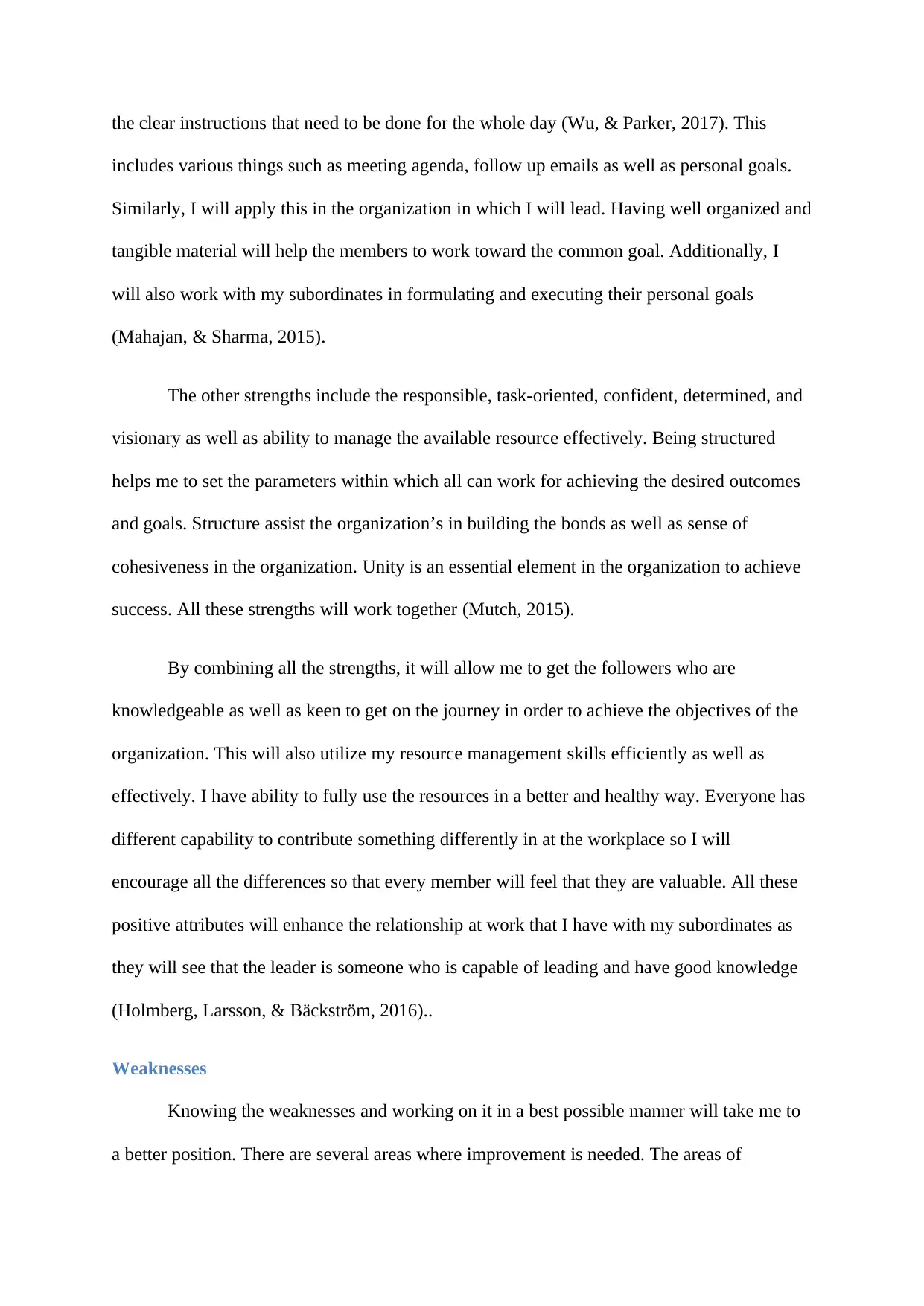
the clear instructions that need to be done for the whole day (Wu, & Parker, 2017). This
includes various things such as meeting agenda, follow up emails as well as personal goals.
Similarly, I will apply this in the organization in which I will lead. Having well organized and
tangible material will help the members to work toward the common goal. Additionally, I
will also work with my subordinates in formulating and executing their personal goals
(Mahajan, & Sharma, 2015).
The other strengths include the responsible, task-oriented, confident, determined, and
visionary as well as ability to manage the available resource effectively. Being structured
helps me to set the parameters within which all can work for achieving the desired outcomes
and goals. Structure assist the organization’s in building the bonds as well as sense of
cohesiveness in the organization. Unity is an essential element in the organization to achieve
success. All these strengths will work together (Mutch, 2015).
By combining all the strengths, it will allow me to get the followers who are
knowledgeable as well as keen to get on the journey in order to achieve the objectives of the
organization. This will also utilize my resource management skills efficiently as well as
effectively. I have ability to fully use the resources in a better and healthy way. Everyone has
different capability to contribute something differently in at the workplace so I will
encourage all the differences so that every member will feel that they are valuable. All these
positive attributes will enhance the relationship at work that I have with my subordinates as
they will see that the leader is someone who is capable of leading and have good knowledge
(Holmberg, Larsson, & Bäckström, 2016)..
Weaknesses
Knowing the weaknesses and working on it in a best possible manner will take me to
a better position. There are several areas where improvement is needed. The areas of
includes various things such as meeting agenda, follow up emails as well as personal goals.
Similarly, I will apply this in the organization in which I will lead. Having well organized and
tangible material will help the members to work toward the common goal. Additionally, I
will also work with my subordinates in formulating and executing their personal goals
(Mahajan, & Sharma, 2015).
The other strengths include the responsible, task-oriented, confident, determined, and
visionary as well as ability to manage the available resource effectively. Being structured
helps me to set the parameters within which all can work for achieving the desired outcomes
and goals. Structure assist the organization’s in building the bonds as well as sense of
cohesiveness in the organization. Unity is an essential element in the organization to achieve
success. All these strengths will work together (Mutch, 2015).
By combining all the strengths, it will allow me to get the followers who are
knowledgeable as well as keen to get on the journey in order to achieve the objectives of the
organization. This will also utilize my resource management skills efficiently as well as
effectively. I have ability to fully use the resources in a better and healthy way. Everyone has
different capability to contribute something differently in at the workplace so I will
encourage all the differences so that every member will feel that they are valuable. All these
positive attributes will enhance the relationship at work that I have with my subordinates as
they will see that the leader is someone who is capable of leading and have good knowledge
(Holmberg, Larsson, & Bäckström, 2016)..
Weaknesses
Knowing the weaknesses and working on it in a best possible manner will take me to
a better position. There are several areas where improvement is needed. The areas of
Paraphrase This Document
Need a fresh take? Get an instant paraphrase of this document with our AI Paraphraser
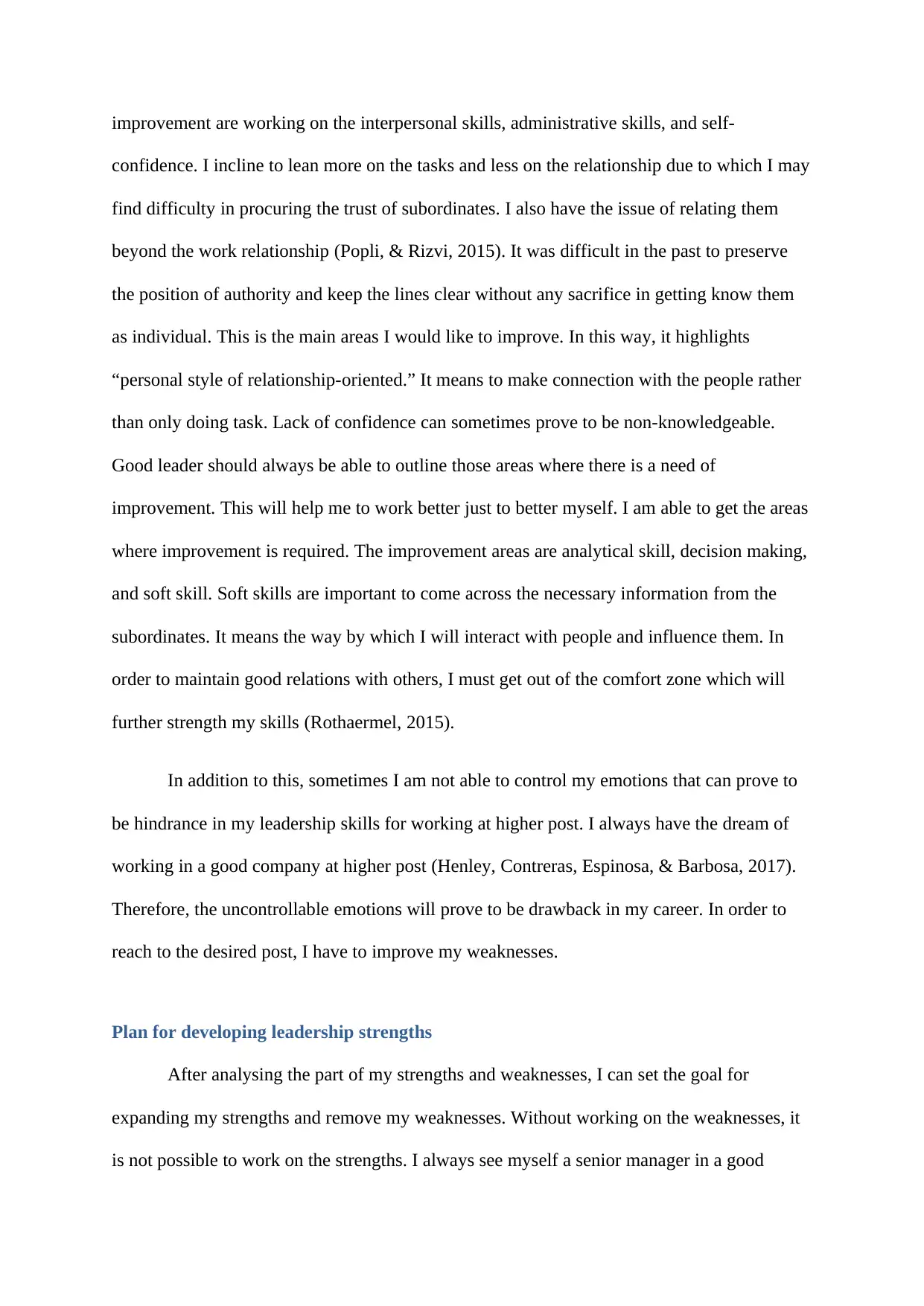
improvement are working on the interpersonal skills, administrative skills, and self-
confidence. I incline to lean more on the tasks and less on the relationship due to which I may
find difficulty in procuring the trust of subordinates. I also have the issue of relating them
beyond the work relationship (Popli, & Rizvi, 2015). It was difficult in the past to preserve
the position of authority and keep the lines clear without any sacrifice in getting know them
as individual. This is the main areas I would like to improve. In this way, it highlights
“personal style of relationship-oriented.” It means to make connection with the people rather
than only doing task. Lack of confidence can sometimes prove to be non-knowledgeable.
Good leader should always be able to outline those areas where there is a need of
improvement. This will help me to work better just to better myself. I am able to get the areas
where improvement is required. The improvement areas are analytical skill, decision making,
and soft skill. Soft skills are important to come across the necessary information from the
subordinates. It means the way by which I will interact with people and influence them. In
order to maintain good relations with others, I must get out of the comfort zone which will
further strength my skills (Rothaermel, 2015).
In addition to this, sometimes I am not able to control my emotions that can prove to
be hindrance in my leadership skills for working at higher post. I always have the dream of
working in a good company at higher post (Henley, Contreras, Espinosa, & Barbosa, 2017).
Therefore, the uncontrollable emotions will prove to be drawback in my career. In order to
reach to the desired post, I have to improve my weaknesses.
Plan for developing leadership strengths
After analysing the part of my strengths and weaknesses, I can set the goal for
expanding my strengths and remove my weaknesses. Without working on the weaknesses, it
is not possible to work on the strengths. I always see myself a senior manager in a good
confidence. I incline to lean more on the tasks and less on the relationship due to which I may
find difficulty in procuring the trust of subordinates. I also have the issue of relating them
beyond the work relationship (Popli, & Rizvi, 2015). It was difficult in the past to preserve
the position of authority and keep the lines clear without any sacrifice in getting know them
as individual. This is the main areas I would like to improve. In this way, it highlights
“personal style of relationship-oriented.” It means to make connection with the people rather
than only doing task. Lack of confidence can sometimes prove to be non-knowledgeable.
Good leader should always be able to outline those areas where there is a need of
improvement. This will help me to work better just to better myself. I am able to get the areas
where improvement is required. The improvement areas are analytical skill, decision making,
and soft skill. Soft skills are important to come across the necessary information from the
subordinates. It means the way by which I will interact with people and influence them. In
order to maintain good relations with others, I must get out of the comfort zone which will
further strength my skills (Rothaermel, 2015).
In addition to this, sometimes I am not able to control my emotions that can prove to
be hindrance in my leadership skills for working at higher post. I always have the dream of
working in a good company at higher post (Henley, Contreras, Espinosa, & Barbosa, 2017).
Therefore, the uncontrollable emotions will prove to be drawback in my career. In order to
reach to the desired post, I have to improve my weaknesses.
Plan for developing leadership strengths
After analysing the part of my strengths and weaknesses, I can set the goal for
expanding my strengths and remove my weaknesses. Without working on the weaknesses, it
is not possible to work on the strengths. I always see myself a senior manager in a good
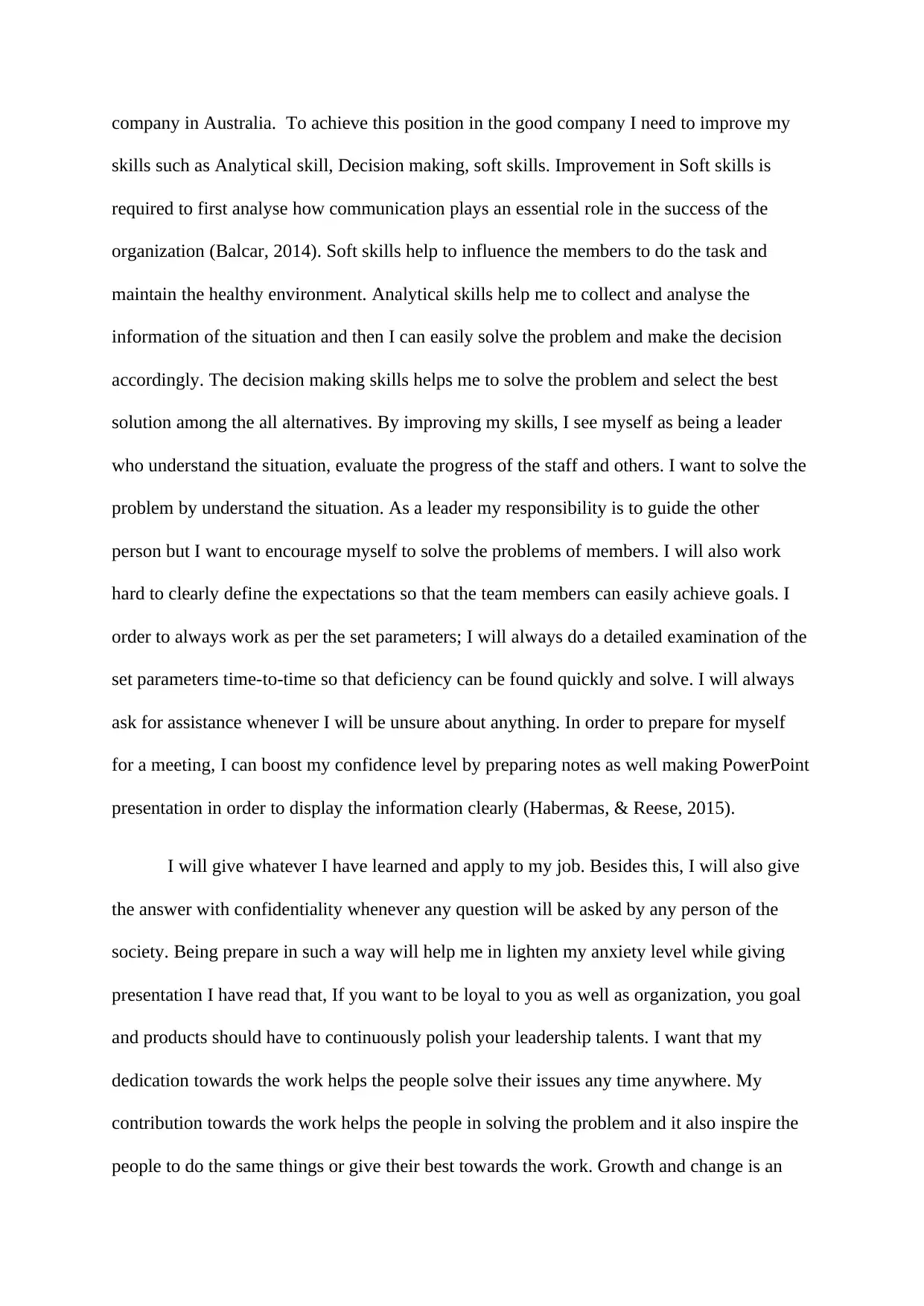
company in Australia. To achieve this position in the good company I need to improve my
skills such as Analytical skill, Decision making, soft skills. Improvement in Soft skills is
required to first analyse how communication plays an essential role in the success of the
organization (Balcar, 2014). Soft skills help to influence the members to do the task and
maintain the healthy environment. Analytical skills help me to collect and analyse the
information of the situation and then I can easily solve the problem and make the decision
accordingly. The decision making skills helps me to solve the problem and select the best
solution among the all alternatives. By improving my skills, I see myself as being a leader
who understand the situation, evaluate the progress of the staff and others. I want to solve the
problem by understand the situation. As a leader my responsibility is to guide the other
person but I want to encourage myself to solve the problems of members. I will also work
hard to clearly define the expectations so that the team members can easily achieve goals. I
order to always work as per the set parameters; I will always do a detailed examination of the
set parameters time-to-time so that deficiency can be found quickly and solve. I will always
ask for assistance whenever I will be unsure about anything. In order to prepare for myself
for a meeting, I can boost my confidence level by preparing notes as well making PowerPoint
presentation in order to display the information clearly (Habermas, & Reese, 2015).
I will give whatever I have learned and apply to my job. Besides this, I will also give
the answer with confidentiality whenever any question will be asked by any person of the
society. Being prepare in such a way will help me in lighten my anxiety level while giving
presentation I have read that, If you want to be loyal to you as well as organization, you goal
and products should have to continuously polish your leadership talents. I want that my
dedication towards the work helps the people solve their issues any time anywhere. My
contribution towards the work helps the people in solving the problem and it also inspire the
people to do the same things or give their best towards the work. Growth and change is an
skills such as Analytical skill, Decision making, soft skills. Improvement in Soft skills is
required to first analyse how communication plays an essential role in the success of the
organization (Balcar, 2014). Soft skills help to influence the members to do the task and
maintain the healthy environment. Analytical skills help me to collect and analyse the
information of the situation and then I can easily solve the problem and make the decision
accordingly. The decision making skills helps me to solve the problem and select the best
solution among the all alternatives. By improving my skills, I see myself as being a leader
who understand the situation, evaluate the progress of the staff and others. I want to solve the
problem by understand the situation. As a leader my responsibility is to guide the other
person but I want to encourage myself to solve the problems of members. I will also work
hard to clearly define the expectations so that the team members can easily achieve goals. I
order to always work as per the set parameters; I will always do a detailed examination of the
set parameters time-to-time so that deficiency can be found quickly and solve. I will always
ask for assistance whenever I will be unsure about anything. In order to prepare for myself
for a meeting, I can boost my confidence level by preparing notes as well making PowerPoint
presentation in order to display the information clearly (Habermas, & Reese, 2015).
I will give whatever I have learned and apply to my job. Besides this, I will also give
the answer with confidentiality whenever any question will be asked by any person of the
society. Being prepare in such a way will help me in lighten my anxiety level while giving
presentation I have read that, If you want to be loyal to you as well as organization, you goal
and products should have to continuously polish your leadership talents. I want that my
dedication towards the work helps the people solve their issues any time anywhere. My
contribution towards the work helps the people in solving the problem and it also inspire the
people to do the same things or give their best towards the work. Growth and change is an
⊘ This is a preview!⊘
Do you want full access?
Subscribe today to unlock all pages.

Trusted by 1+ million students worldwide
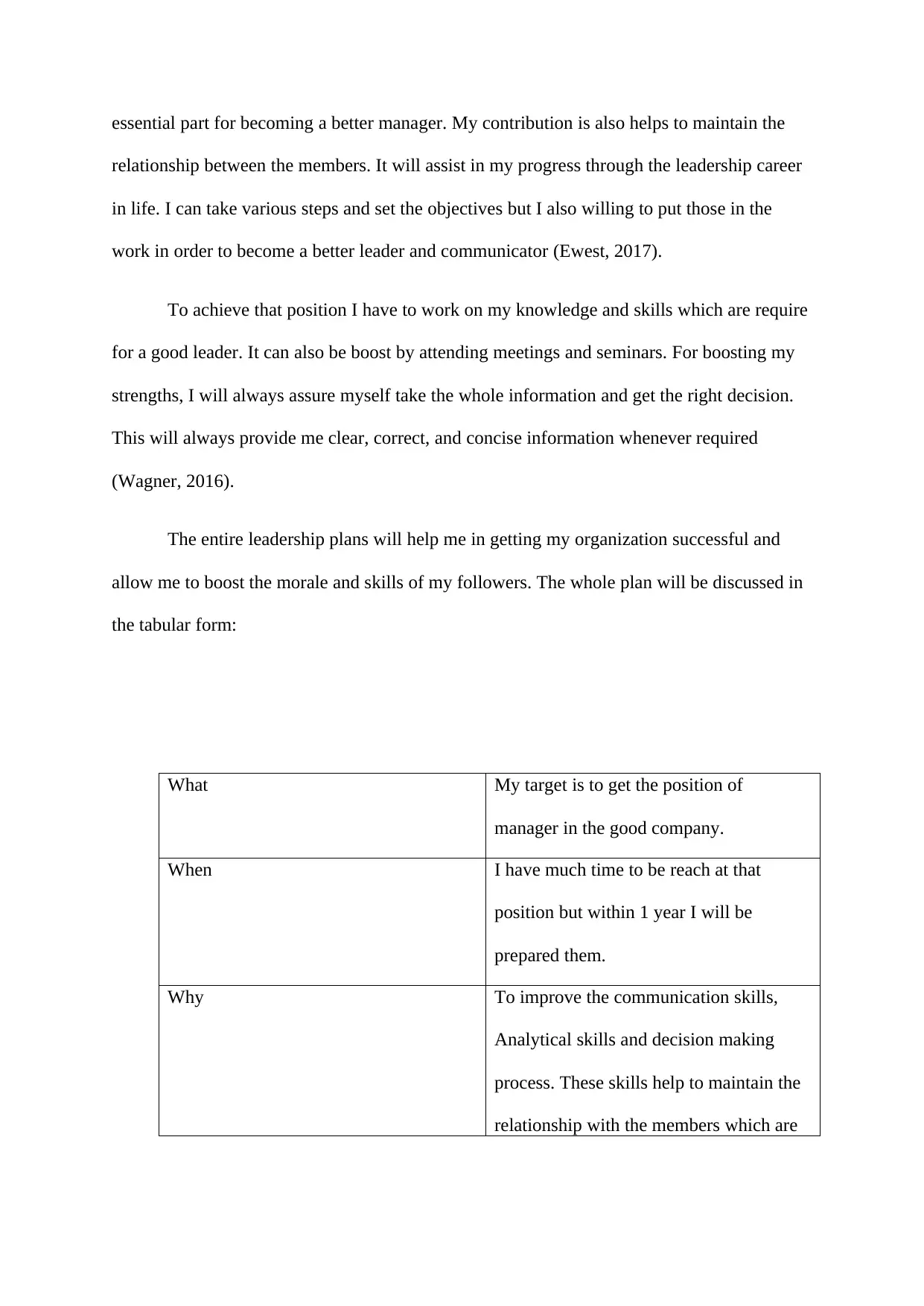
essential part for becoming a better manager. My contribution is also helps to maintain the
relationship between the members. It will assist in my progress through the leadership career
in life. I can take various steps and set the objectives but I also willing to put those in the
work in order to become a better leader and communicator (Ewest, 2017).
To achieve that position I have to work on my knowledge and skills which are require
for a good leader. It can also be boost by attending meetings and seminars. For boosting my
strengths, I will always assure myself take the whole information and get the right decision.
This will always provide me clear, correct, and concise information whenever required
(Wagner, 2016).
The entire leadership plans will help me in getting my organization successful and
allow me to boost the morale and skills of my followers. The whole plan will be discussed in
the tabular form:
What My target is to get the position of
manager in the good company.
When I have much time to be reach at that
position but within 1 year I will be
prepared them.
Why To improve the communication skills,
Analytical skills and decision making
process. These skills help to maintain the
relationship with the members which are
relationship between the members. It will assist in my progress through the leadership career
in life. I can take various steps and set the objectives but I also willing to put those in the
work in order to become a better leader and communicator (Ewest, 2017).
To achieve that position I have to work on my knowledge and skills which are require
for a good leader. It can also be boost by attending meetings and seminars. For boosting my
strengths, I will always assure myself take the whole information and get the right decision.
This will always provide me clear, correct, and concise information whenever required
(Wagner, 2016).
The entire leadership plans will help me in getting my organization successful and
allow me to boost the morale and skills of my followers. The whole plan will be discussed in
the tabular form:
What My target is to get the position of
manager in the good company.
When I have much time to be reach at that
position but within 1 year I will be
prepared them.
Why To improve the communication skills,
Analytical skills and decision making
process. These skills help to maintain the
relationship with the members which are
Paraphrase This Document
Need a fresh take? Get an instant paraphrase of this document with our AI Paraphraser
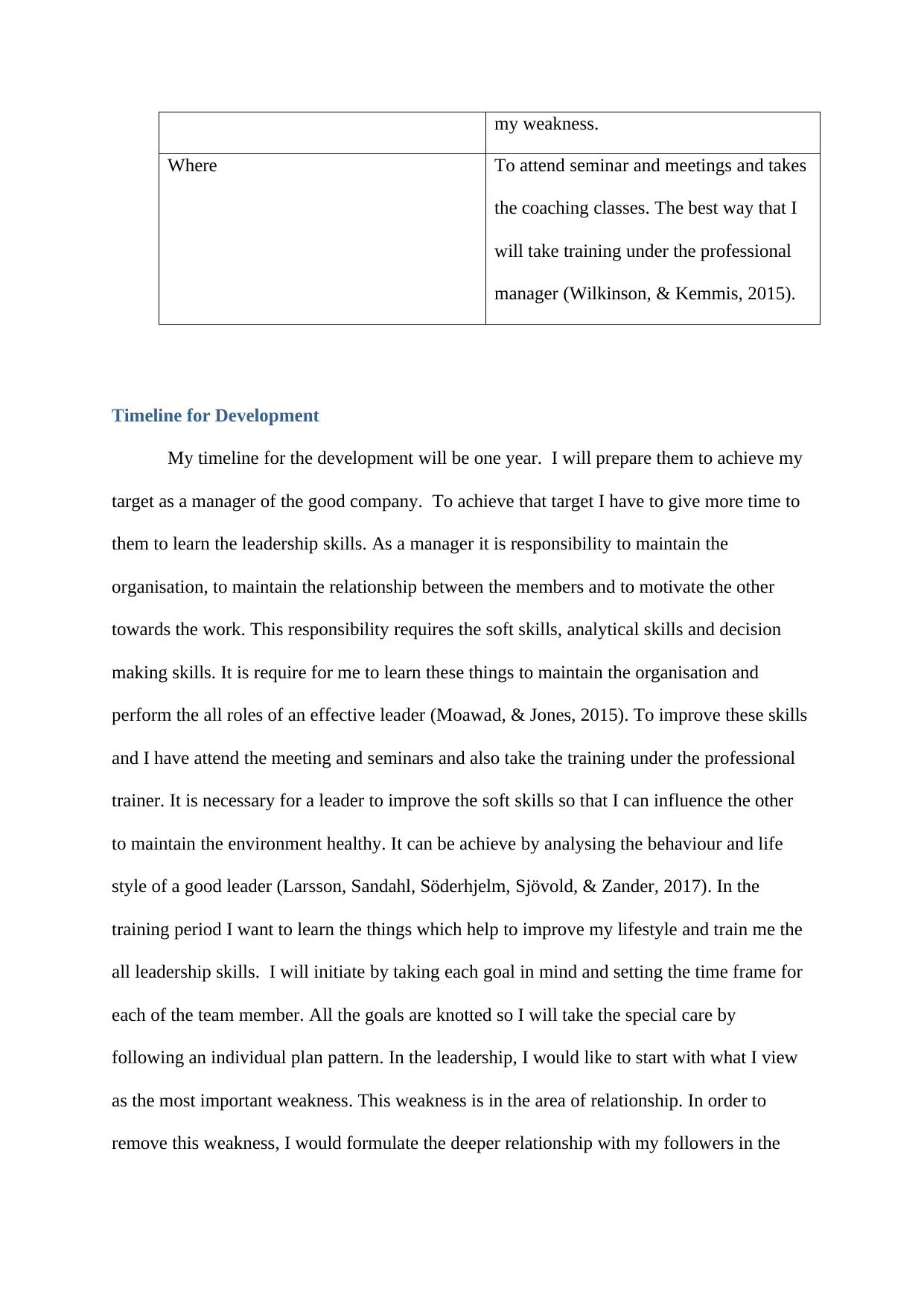
my weakness.
Where To attend seminar and meetings and takes
the coaching classes. The best way that I
will take training under the professional
manager (Wilkinson, & Kemmis, 2015).
Timeline for Development
My timeline for the development will be one year. I will prepare them to achieve my
target as a manager of the good company. To achieve that target I have to give more time to
them to learn the leadership skills. As a manager it is responsibility to maintain the
organisation, to maintain the relationship between the members and to motivate the other
towards the work. This responsibility requires the soft skills, analytical skills and decision
making skills. It is require for me to learn these things to maintain the organisation and
perform the all roles of an effective leader (Moawad, & Jones, 2015). To improve these skills
and I have attend the meeting and seminars and also take the training under the professional
trainer. It is necessary for a leader to improve the soft skills so that I can influence the other
to maintain the environment healthy. It can be achieve by analysing the behaviour and life
style of a good leader (Larsson, Sandahl, Söderhjelm, Sjövold, & Zander, 2017). In the
training period I want to learn the things which help to improve my lifestyle and train me the
all leadership skills. I will initiate by taking each goal in mind and setting the time frame for
each of the team member. All the goals are knotted so I will take the special care by
following an individual plan pattern. In the leadership, I would like to start with what I view
as the most important weakness. This weakness is in the area of relationship. In order to
remove this weakness, I would formulate the deeper relationship with my followers in the
Where To attend seminar and meetings and takes
the coaching classes. The best way that I
will take training under the professional
manager (Wilkinson, & Kemmis, 2015).
Timeline for Development
My timeline for the development will be one year. I will prepare them to achieve my
target as a manager of the good company. To achieve that target I have to give more time to
them to learn the leadership skills. As a manager it is responsibility to maintain the
organisation, to maintain the relationship between the members and to motivate the other
towards the work. This responsibility requires the soft skills, analytical skills and decision
making skills. It is require for me to learn these things to maintain the organisation and
perform the all roles of an effective leader (Moawad, & Jones, 2015). To improve these skills
and I have attend the meeting and seminars and also take the training under the professional
trainer. It is necessary for a leader to improve the soft skills so that I can influence the other
to maintain the environment healthy. It can be achieve by analysing the behaviour and life
style of a good leader (Larsson, Sandahl, Söderhjelm, Sjövold, & Zander, 2017). In the
training period I want to learn the things which help to improve my lifestyle and train me the
all leadership skills. I will initiate by taking each goal in mind and setting the time frame for
each of the team member. All the goals are knotted so I will take the special care by
following an individual plan pattern. In the leadership, I would like to start with what I view
as the most important weakness. This weakness is in the area of relationship. In order to
remove this weakness, I would formulate the deeper relationship with my followers in the
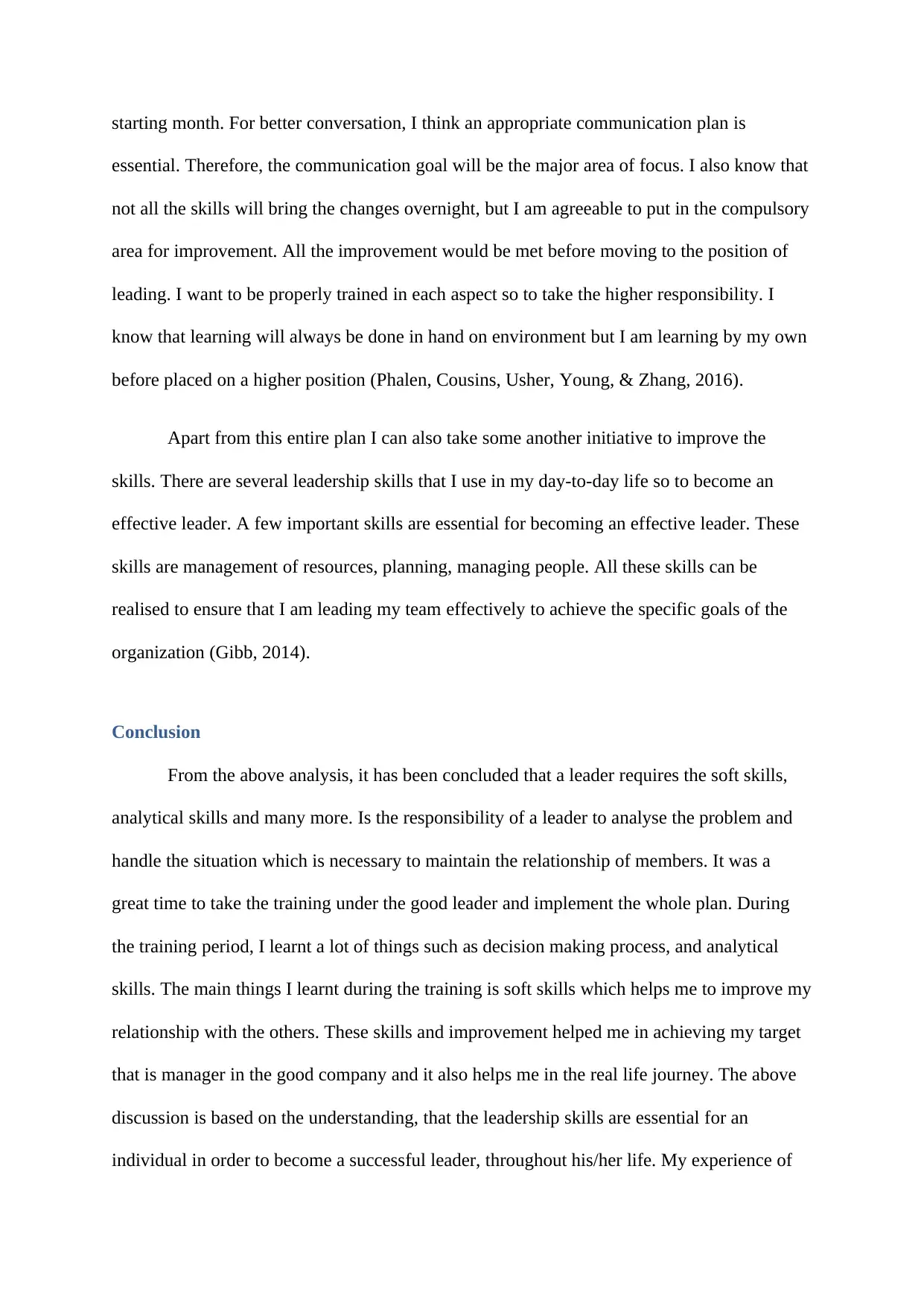
starting month. For better conversation, I think an appropriate communication plan is
essential. Therefore, the communication goal will be the major area of focus. I also know that
not all the skills will bring the changes overnight, but I am agreeable to put in the compulsory
area for improvement. All the improvement would be met before moving to the position of
leading. I want to be properly trained in each aspect so to take the higher responsibility. I
know that learning will always be done in hand on environment but I am learning by my own
before placed on a higher position (Phalen, Cousins, Usher, Young, & Zhang, 2016).
Apart from this entire plan I can also take some another initiative to improve the
skills. There are several leadership skills that I use in my day-to-day life so to become an
effective leader. A few important skills are essential for becoming an effective leader. These
skills are management of resources, planning, managing people. All these skills can be
realised to ensure that I am leading my team effectively to achieve the specific goals of the
organization (Gibb, 2014).
Conclusion
From the above analysis, it has been concluded that a leader requires the soft skills,
analytical skills and many more. Is the responsibility of a leader to analyse the problem and
handle the situation which is necessary to maintain the relationship of members. It was a
great time to take the training under the good leader and implement the whole plan. During
the training period, I learnt a lot of things such as decision making process, and analytical
skills. The main things I learnt during the training is soft skills which helps me to improve my
relationship with the others. These skills and improvement helped me in achieving my target
that is manager in the good company and it also helps me in the real life journey. The above
discussion is based on the understanding, that the leadership skills are essential for an
individual in order to become a successful leader, throughout his/her life. My experience of
essential. Therefore, the communication goal will be the major area of focus. I also know that
not all the skills will bring the changes overnight, but I am agreeable to put in the compulsory
area for improvement. All the improvement would be met before moving to the position of
leading. I want to be properly trained in each aspect so to take the higher responsibility. I
know that learning will always be done in hand on environment but I am learning by my own
before placed on a higher position (Phalen, Cousins, Usher, Young, & Zhang, 2016).
Apart from this entire plan I can also take some another initiative to improve the
skills. There are several leadership skills that I use in my day-to-day life so to become an
effective leader. A few important skills are essential for becoming an effective leader. These
skills are management of resources, planning, managing people. All these skills can be
realised to ensure that I am leading my team effectively to achieve the specific goals of the
organization (Gibb, 2014).
Conclusion
From the above analysis, it has been concluded that a leader requires the soft skills,
analytical skills and many more. Is the responsibility of a leader to analyse the problem and
handle the situation which is necessary to maintain the relationship of members. It was a
great time to take the training under the good leader and implement the whole plan. During
the training period, I learnt a lot of things such as decision making process, and analytical
skills. The main things I learnt during the training is soft skills which helps me to improve my
relationship with the others. These skills and improvement helped me in achieving my target
that is manager in the good company and it also helps me in the real life journey. The above
discussion is based on the understanding, that the leadership skills are essential for an
individual in order to become a successful leader, throughout his/her life. My experience of
⊘ This is a preview!⊘
Do you want full access?
Subscribe today to unlock all pages.

Trusted by 1+ million students worldwide
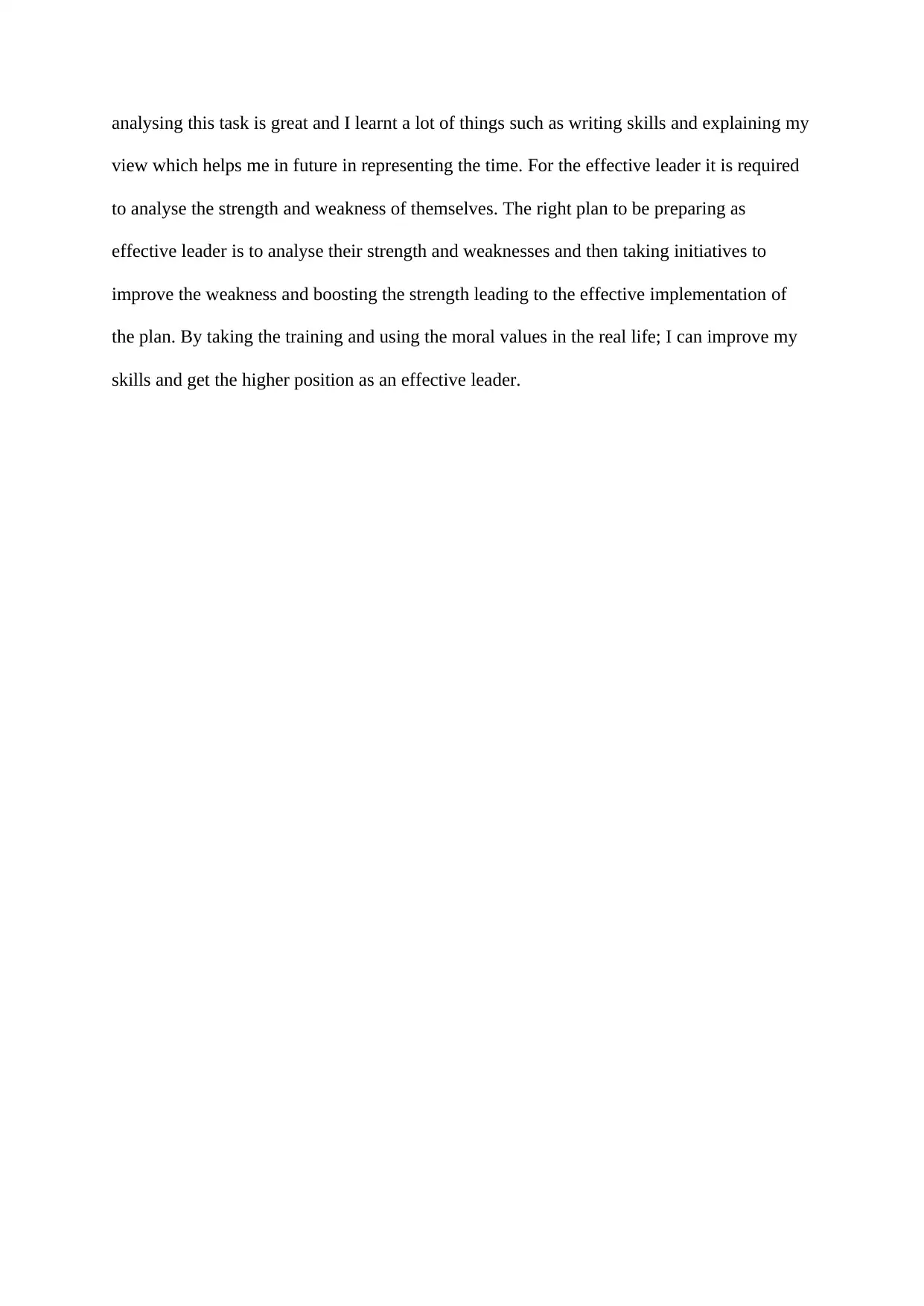
analysing this task is great and I learnt a lot of things such as writing skills and explaining my
view which helps me in future in representing the time. For the effective leader it is required
to analyse the strength and weakness of themselves. The right plan to be preparing as
effective leader is to analyse their strength and weaknesses and then taking initiatives to
improve the weakness and boosting the strength leading to the effective implementation of
the plan. By taking the training and using the moral values in the real life; I can improve my
skills and get the higher position as an effective leader.
view which helps me in future in representing the time. For the effective leader it is required
to analyse the strength and weakness of themselves. The right plan to be preparing as
effective leader is to analyse their strength and weaknesses and then taking initiatives to
improve the weakness and boosting the strength leading to the effective implementation of
the plan. By taking the training and using the moral values in the real life; I can improve my
skills and get the higher position as an effective leader.
Paraphrase This Document
Need a fresh take? Get an instant paraphrase of this document with our AI Paraphraser
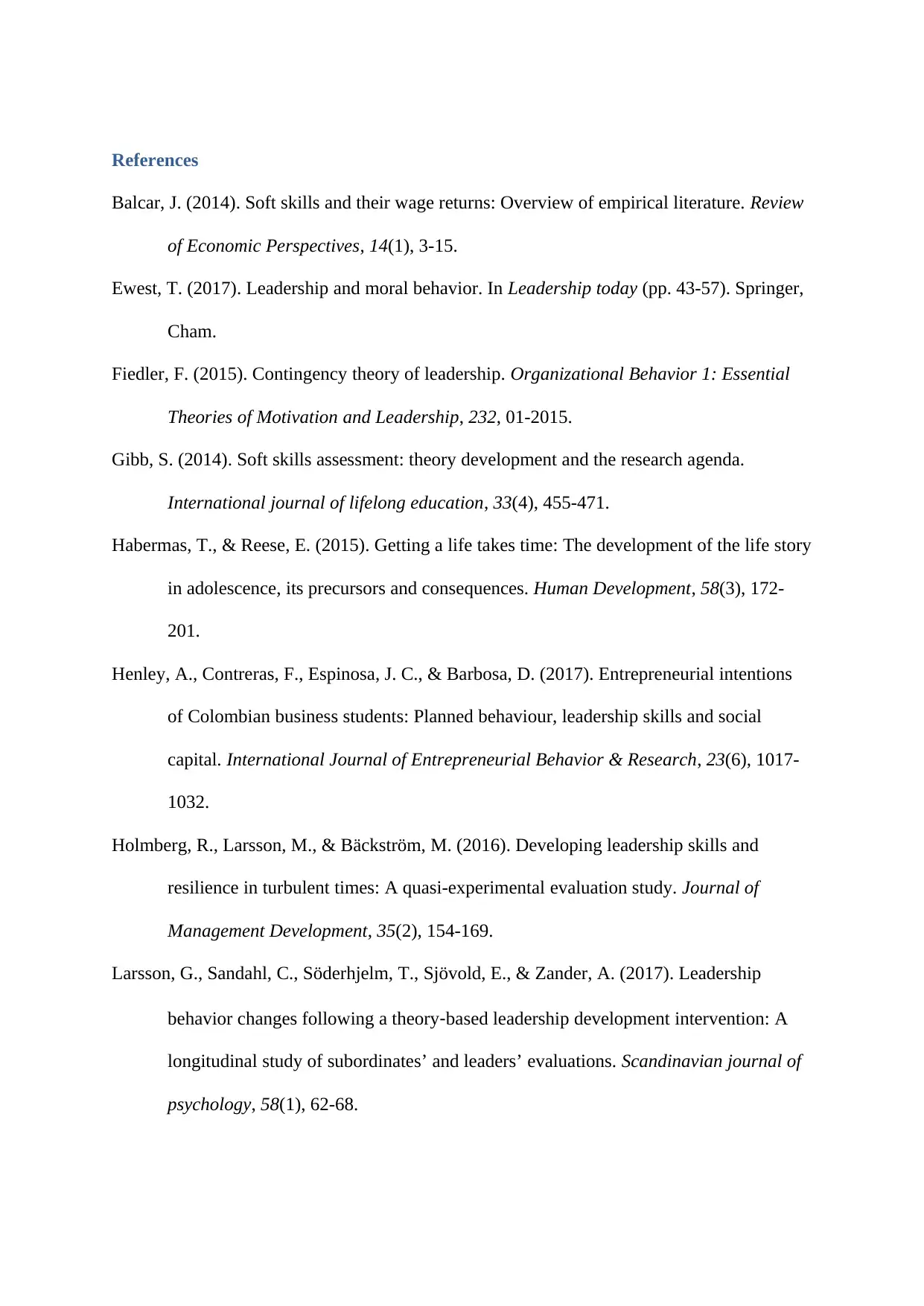
References
Balcar, J. (2014). Soft skills and their wage returns: Overview of empirical literature. Review
of Economic Perspectives, 14(1), 3-15.
Ewest, T. (2017). Leadership and moral behavior. In Leadership today (pp. 43-57). Springer,
Cham.
Fiedler, F. (2015). Contingency theory of leadership. Organizational Behavior 1: Essential
Theories of Motivation and Leadership, 232, 01-2015.
Gibb, S. (2014). Soft skills assessment: theory development and the research agenda.
International journal of lifelong education, 33(4), 455-471.
Habermas, T., & Reese, E. (2015). Getting a life takes time: The development of the life story
in adolescence, its precursors and consequences. Human Development, 58(3), 172-
201.
Henley, A., Contreras, F., Espinosa, J. C., & Barbosa, D. (2017). Entrepreneurial intentions
of Colombian business students: Planned behaviour, leadership skills and social
capital. International Journal of Entrepreneurial Behavior & Research, 23(6), 1017-
1032.
Holmberg, R., Larsson, M., & Bäckström, M. (2016). Developing leadership skills and
resilience in turbulent times: A quasi-experimental evaluation study. Journal of
Management Development, 35(2), 154-169.
Larsson, G., Sandahl, C., Söderhjelm, T., Sjövold, E., & Zander, A. (2017). Leadership
behavior changes following a theory‐based leadership development intervention: A
longitudinal study of subordinates’ and leaders’ evaluations. Scandinavian journal of
psychology, 58(1), 62-68.
Balcar, J. (2014). Soft skills and their wage returns: Overview of empirical literature. Review
of Economic Perspectives, 14(1), 3-15.
Ewest, T. (2017). Leadership and moral behavior. In Leadership today (pp. 43-57). Springer,
Cham.
Fiedler, F. (2015). Contingency theory of leadership. Organizational Behavior 1: Essential
Theories of Motivation and Leadership, 232, 01-2015.
Gibb, S. (2014). Soft skills assessment: theory development and the research agenda.
International journal of lifelong education, 33(4), 455-471.
Habermas, T., & Reese, E. (2015). Getting a life takes time: The development of the life story
in adolescence, its precursors and consequences. Human Development, 58(3), 172-
201.
Henley, A., Contreras, F., Espinosa, J. C., & Barbosa, D. (2017). Entrepreneurial intentions
of Colombian business students: Planned behaviour, leadership skills and social
capital. International Journal of Entrepreneurial Behavior & Research, 23(6), 1017-
1032.
Holmberg, R., Larsson, M., & Bäckström, M. (2016). Developing leadership skills and
resilience in turbulent times: A quasi-experimental evaluation study. Journal of
Management Development, 35(2), 154-169.
Larsson, G., Sandahl, C., Söderhjelm, T., Sjövold, E., & Zander, A. (2017). Leadership
behavior changes following a theory‐based leadership development intervention: A
longitudinal study of subordinates’ and leaders’ evaluations. Scandinavian journal of
psychology, 58(1), 62-68.
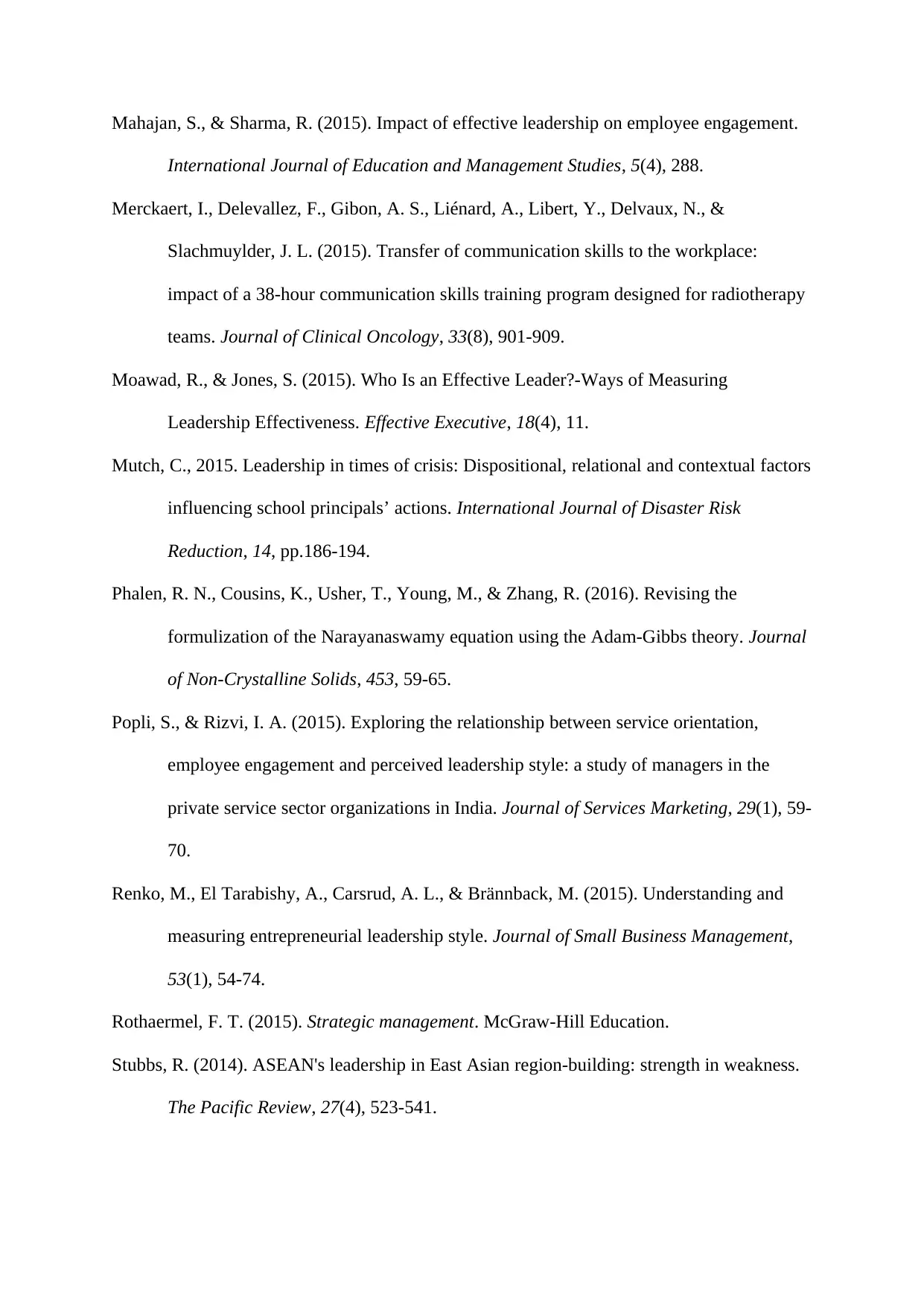
Mahajan, S., & Sharma, R. (2015). Impact of effective leadership on employee engagement.
International Journal of Education and Management Studies, 5(4), 288.
Merckaert, I., Delevallez, F., Gibon, A. S., Liénard, A., Libert, Y., Delvaux, N., &
Slachmuylder, J. L. (2015). Transfer of communication skills to the workplace:
impact of a 38-hour communication skills training program designed for radiotherapy
teams. Journal of Clinical Oncology, 33(8), 901-909.
Moawad, R., & Jones, S. (2015). Who Is an Effective Leader?-Ways of Measuring
Leadership Effectiveness. Effective Executive, 18(4), 11.
Mutch, C., 2015. Leadership in times of crisis: Dispositional, relational and contextual factors
influencing school principals’ actions. International Journal of Disaster Risk
Reduction, 14, pp.186-194.
Phalen, R. N., Cousins, K., Usher, T., Young, M., & Zhang, R. (2016). Revising the
formulization of the Narayanaswamy equation using the Adam-Gibbs theory. Journal
of Non-Crystalline Solids, 453, 59-65.
Popli, S., & Rizvi, I. A. (2015). Exploring the relationship between service orientation,
employee engagement and perceived leadership style: a study of managers in the
private service sector organizations in India. Journal of Services Marketing, 29(1), 59-
70.
Renko, M., El Tarabishy, A., Carsrud, A. L., & Brännback, M. (2015). Understanding and
measuring entrepreneurial leadership style. Journal of Small Business Management,
53(1), 54-74.
Rothaermel, F. T. (2015). Strategic management. McGraw-Hill Education.
Stubbs, R. (2014). ASEAN's leadership in East Asian region-building: strength in weakness.
The Pacific Review, 27(4), 523-541.
International Journal of Education and Management Studies, 5(4), 288.
Merckaert, I., Delevallez, F., Gibon, A. S., Liénard, A., Libert, Y., Delvaux, N., &
Slachmuylder, J. L. (2015). Transfer of communication skills to the workplace:
impact of a 38-hour communication skills training program designed for radiotherapy
teams. Journal of Clinical Oncology, 33(8), 901-909.
Moawad, R., & Jones, S. (2015). Who Is an Effective Leader?-Ways of Measuring
Leadership Effectiveness. Effective Executive, 18(4), 11.
Mutch, C., 2015. Leadership in times of crisis: Dispositional, relational and contextual factors
influencing school principals’ actions. International Journal of Disaster Risk
Reduction, 14, pp.186-194.
Phalen, R. N., Cousins, K., Usher, T., Young, M., & Zhang, R. (2016). Revising the
formulization of the Narayanaswamy equation using the Adam-Gibbs theory. Journal
of Non-Crystalline Solids, 453, 59-65.
Popli, S., & Rizvi, I. A. (2015). Exploring the relationship between service orientation,
employee engagement and perceived leadership style: a study of managers in the
private service sector organizations in India. Journal of Services Marketing, 29(1), 59-
70.
Renko, M., El Tarabishy, A., Carsrud, A. L., & Brännback, M. (2015). Understanding and
measuring entrepreneurial leadership style. Journal of Small Business Management,
53(1), 54-74.
Rothaermel, F. T. (2015). Strategic management. McGraw-Hill Education.
Stubbs, R. (2014). ASEAN's leadership in East Asian region-building: strength in weakness.
The Pacific Review, 27(4), 523-541.
⊘ This is a preview!⊘
Do you want full access?
Subscribe today to unlock all pages.

Trusted by 1+ million students worldwide
1 out of 13
Related Documents
Your All-in-One AI-Powered Toolkit for Academic Success.
+13062052269
info@desklib.com
Available 24*7 on WhatsApp / Email
![[object Object]](/_next/static/media/star-bottom.7253800d.svg)
Unlock your academic potential
Copyright © 2020–2025 A2Z Services. All Rights Reserved. Developed and managed by ZUCOL.



